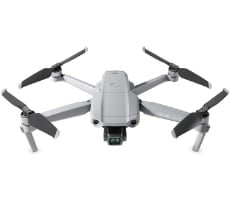DJI Mavic Air Drone Review: A Compact, Powerful Eye In The Sky
DJI has gone to great lengths in recent years to appeal to consumers looking for more portable devices. As a photographer, I carry a camera bag littered with lenses and DSLR bodies; but most will agree that something like DJI's earlier Phantom drones were simply too large to consider highly portable. With DJI’s latest and greatest drone, the Mavic Air, however, photographers and videographers alike are able to carry a foldable, simple to deploy, and extremely easy to use airborne 4K camera in their gear bag or even their cargo shorts' pocket.
If you’re familiar with aerial photography, more specifically cinematic drones (yes, the ones that caused all the friction between FAA and wannabe pilots), then you know that DJI has been one of, if not the biggest name in the market for high-end consumer and professional drones. Still, when some folks think of DJI, a picture of the original Phantom drone is the first thing that comes to mind. The Mavic Air is a completely different platform approach, however, that has brought 4K cinematic aerial photography to consumers in a pocket sized format. While in the past, high end drones were out of reach for most hobbyists due to budget constraints, the Air (priced at $799) is a attainable tool for almost any photographer looking to get a bird’s eye view of their target shooting area.
The DJI Mavic Air In Action
|
| Takeoff Weight: | 430g |
| Dimensions: | Folded - 168×83×49 mm, Unfolded - 168×184×64 mm (L×W×H) |
| Maximum Speed: | 68.4 kph (S - mode), 28.8 kph (P - mode) |
| Maximum Flight Time: | 21 minutes (at a consistent 25 kph) |
| Maximum Flight Distance: | 10 km |
| Battery Capacity: | 2375mAh (11.55V, LiPo 3S) |
| Maximum Wind Speed Resistance: | 29 - 38 kph |
| Operating Frequencies: | 2.400 - 2.4835 GHz, 5.725 - 5.850 GHz |
| Internal Storage: | 8GB |
| Supported SD Storage: | MicroSD (Class 10 or UHS-1 rating) |
| Gimbal Mechanical Range: | Tilt: -100° to 22°, Roll: -30° to 30°, Pan: -12° to 12° |
| Gimbal Angular Vibration Range: | ±0.005° |
| Camera Specifications: | |
| Camera Sensor: | 1/2.3” CMOS |
| Effective Pixels: | 12 MP |
| Camera Lens FOV: | 85° |
| 35 mm Format Equivalent: | 24 mm |
| Aperture: | f/2.8 (fixed) |
| Shooting Range: | 0.5 m to ? |
| ISO Range: | 100-3200 (Video and Photo) |
| Shutter Speed Range: | 8-1/8000s |
| Forward Sensing System: | Precision Measurement Range: 0.5 - 12 m, ;Detectable Range: 0.5 - 24 m |
| Backward Sensing System: | Precision Measurement Range: 0.5 - 10 m, Detectable Range: 0.5 - 20 m |
| Downward Sensing System: | Altitude Range: 0.1 - 8 m, Operating Range: 0.5 - 30 m |
| Still Image Specs: | 4:3: 4056×3040, 16:9: 4056×2280 |
| Photo Format: | JPEG/DNG (RAW) |
| Video Resolutions: | 4K Ultra HD: 3840×2160 Up to 30p, 2.7K: 2720×1530 Up To 60p, FHD: 1920×1080 Up To 120p, HD: 1280×720 Up To 120p |
| Transmitted Video to Mobile Device: | 720p@30fps |
| Video Format: | MP4/MOV (H.264/MPEG-4 AVC) |
The new Mavic Air still incorporates the trademark features that DJI is known for, though. By combining the folding arm platform of the Mavic Pro with the small footprint of the Spark, the Air is a hybrid of its siblings. Targeting the middle of the market, and focused on portability and performance, DJI designed an appealing addition to its fleet of already highly respected cinematic drones.
In many ways, the Air is a more up-to-date platform compared to the Pro and Spark series. A buttery-smooth, redesigned gimbal proved itself up to any task out in the field. No matter the wind, aircraft movement, or altitude, we were able to record impressively stable 4K and 1080p footage from the small aircraft.
Additionally, the Air features a variety of software enhancements, including a handful of new quick-shot flight modes (Spherical Panorama, Asteroid, and Boomerang). Furthermore, the drone is capable of using DJI’s newer, up-to-date Active Track software and Gesture Modes, both of which have been significantly improved in comparison to their original appearance in the DJI Spark. These new flight modes allow users to put the controller down and control their drone through hand motions or using the on-board camera to follow subjects. In our opinion, it seems logical that these software-based updates will be seen in DJI’s full drone line up in the near future as well.
Where the Mavic Air sets itself apart is with its obstacle avoidance system. Wielding 7 cameras, the tiny drone is able to sense obstacles in three dimensions, an improvement upon the Pro’s two direction avoidance system. While testing, we found that having the backwards facing cameras proved valuable and prevented a few, potentially dangerous (and expensive) collisions. Considering how well the the three dimensional system worked, we look forward to testing the omni-dimensional pilot assistance system implemented in the recently announced DJI Mavic Pro 2 series.








